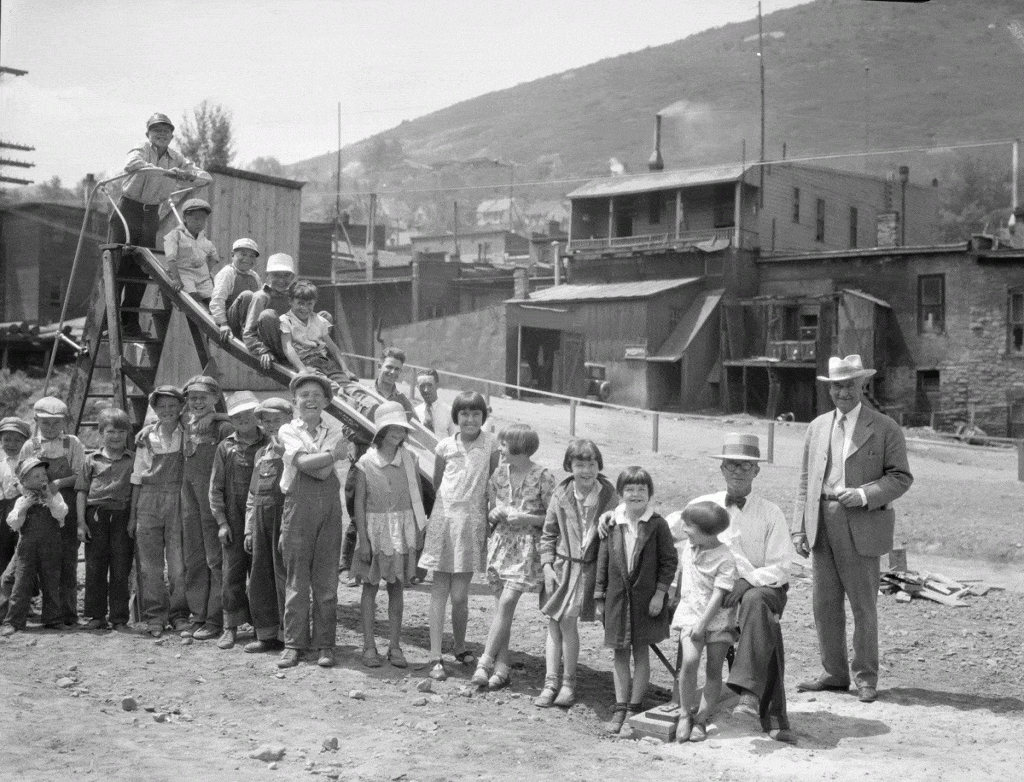For many of us, it’s impossible to remember our childhoods without recalling time spent at a playground, climbing the jungle gym, jumping off swings, or spinning on the merry-go-round. However, in America at the turn of the twentieth century, providing dedicated outdoor areas with equipment on which children could play was a fairly new concept. While today Park City has at least nine public playgrounds, before 1929, we didn’t even have one!
Inspired by German philosophy that emphasized the health benefits of outdoor exercise, the playground movement in the United States began with the sand gardens of Boston in the 1880s. The movement was primarily a response to negative impacts of the industrial revolution, specifically crowded urban life and long hours spent in factories. At first, playgrounds were seen as necessary only in urban areas, which lacked the space and nature abundant in smaller towns and the countryside. In the following years, many involved in the movement saw additional social, moral, physical and educational benefits to children, and deemed playgrounds essential for all cities and towns.[1]
In Park City, the playground movement was mentioned as early as 1910 in a Park Record newpaper article that called for greater civic improvement to make an “ideal town,” including clean streets, good schools and playgrounds.[2] However, it wasn’t until 1925 that a concentrated effort was made to raise funds for Park City’s first playground. A dedicated group of citizens, including members of the Parent Teacher Association, the Woman’s Athenaeum and the American Legion, spent years raising funds and encouraging the town to support the building of a playground so that children “will be benefited and made happy.”[3]
While many citizens contributed to the cause, the issue of securing a location delayed progress for several years. Finally, in 1928 officials from the Park Utah Consolidated Mining Company donated a stretch of land that ran from China Bridge north past the rear of the Elks Hall at 550 Main Street. Before the playground could be installed, the Marsac machine shop, sheds and garages had to be removed, the ground beneath leveled, and Silver Creek covered.[4]
Once work was finished, the land was ready for equipment. The Kiwanis donated the first batch, a Giant Slide and a Giant Stride installed during the summer of 1929. Soon after, a local company donated a wire fence to circle the perimeter, and the Park City Fire Department installed two water fountains on the grounds. Steadily more equipment was added, and by summer’s end, “the kids at the playground [were] trying hard to wear out their pants and pantaloons on the teeter-boards and chutes.”[5]

Credit: Park City Historical Society & Museum, Pop Jenks Collection
Today we may take playgrounds for granted, but just remember, a century ago Park City didn’t have one! To view a visual chronology of playground equipment through the decades, and to learn more about the playground movement, stop by the Park City Museum to see Once Upon a Playground, an exhibit that takes visitors on a nostalgic trip through playgrounds of our past. Open now until October 16.
[1] Frost, Joe L. A History of Children’s Play and Play Environments. Pages 89-97.
[2] Park Record. “For an Ideal Town.” 1910-11-12.
[3] Park Record. “Help Children’s Playground Movement.” 1925-01-23.
[4] Park Record. “Progress of Playgrounds.” 1928-07-06.
[5] Park Record. “Stroller Notices.” 1929-08-23.